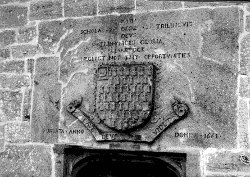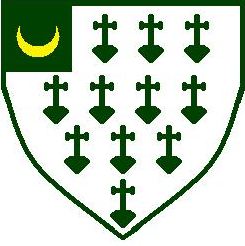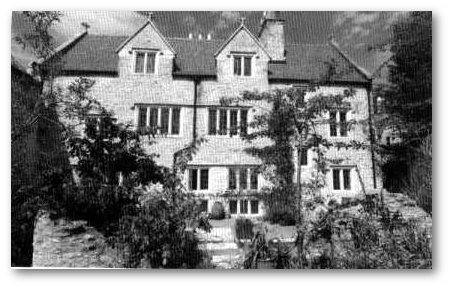Martock's coat of arms
Written by Fergus

Above left: The overdoor inserted in about 1661 by William Strode into the 15th century Church House, now known as the Court House, when it became a school. 'Martock, neglect not thy opportunities, it says.
Above right: The shield of the Strode family.. It represents, in typically curious heraldic language: ermine (the winter coat of the stoat), with a crescent in a 'canton' in the top left corner. This is the correct colouing recognised by the College of Arms, see below for a fuller explanation.
Martock now uses the shield carved into the headstone over the main doorway of the Court House. The Court House was built in the late 15th century as a 'Church House'. The Church House was was renovated and re-roofed as a school by the then Lord of the Manor of Martock, William Strode of Barrington, in 1661.
The Court House contains a huge fireplace (amoke bay) used as the communal bakehouse for those who couldn’t afford their own fire at hom. It was also used to brew ale (beer without the hops) which was sold on Sundays, the whole building being used to generate funds for the re-building of All Saint’s Church, which was in full swing from about 1485 until about 1516. Gatherings took place on the first floor, the whole of which was one large room.
Heraldry uses a bizarre form of anglicised Latin, and the Strode shield is described thus in the Heralds Visitation of Somerset in 1623: ‘Ermine, on a canton sable a crescent argent’ Translated, this means that the main part of the shield is ermine. This is the much prized and expensive fur of the stoat, which was used to trim the coats of royalty and is still worn by members of the House of Lords at ceremonial occasions today. In the winter the fur of the stoat goes white, but retains its flecking. In the winter its belly would turn white, with black flecks on it, and this is the sought after colouring represented on the Strode shield. So the shield is white, with artistic license used to depict the black flecks. In the top left corner is a sable (black) canton (corner) with a gold crescent. This is a device of ‘difference’, used in heraldry to denote that this shield is born by the second son of the family, while the eldest son would use a pure, ’un-differenced’ shield.
This ‘second son’ seems to have occurred several generation earlier, as all Strodes by the mid-17th century were using the ‘second son’ device on their coat of arms. The motto of the Strode family, carved below the shield, is ‘Cave, Deus ipse videt’. This may be translated as ‘Beware, God himself is watching over you’. Above the Strode shield on the Court House door are the words ‘Martock, neglect not thy opportunities’. This has also been adopted by the parish council as our motto. The ‘William Strode of Barrington’ who left his mark so beautifully on Martock was the third son of James Strode of Shepton Mallett. James Strode’s house at no. 8, Market Place, has recently been lovingly restored. William was also a wealthy merchant, and seems to have had a hazardous, heavily-mortgaged interest in the manor of Barrington, and it is of Barrington that we now know him, to differentiate him from all the other William Strodes. The Strode family were prosperous in the 17th century, owning many handsome properties such as Parnhma (Beaminster) and Southill (Shepton Mallet).
 8, Market Place, Shepton Mallet, built by another Willeam Strode.
8, Market Place, Shepton Mallet, built by another Willeam Strode.